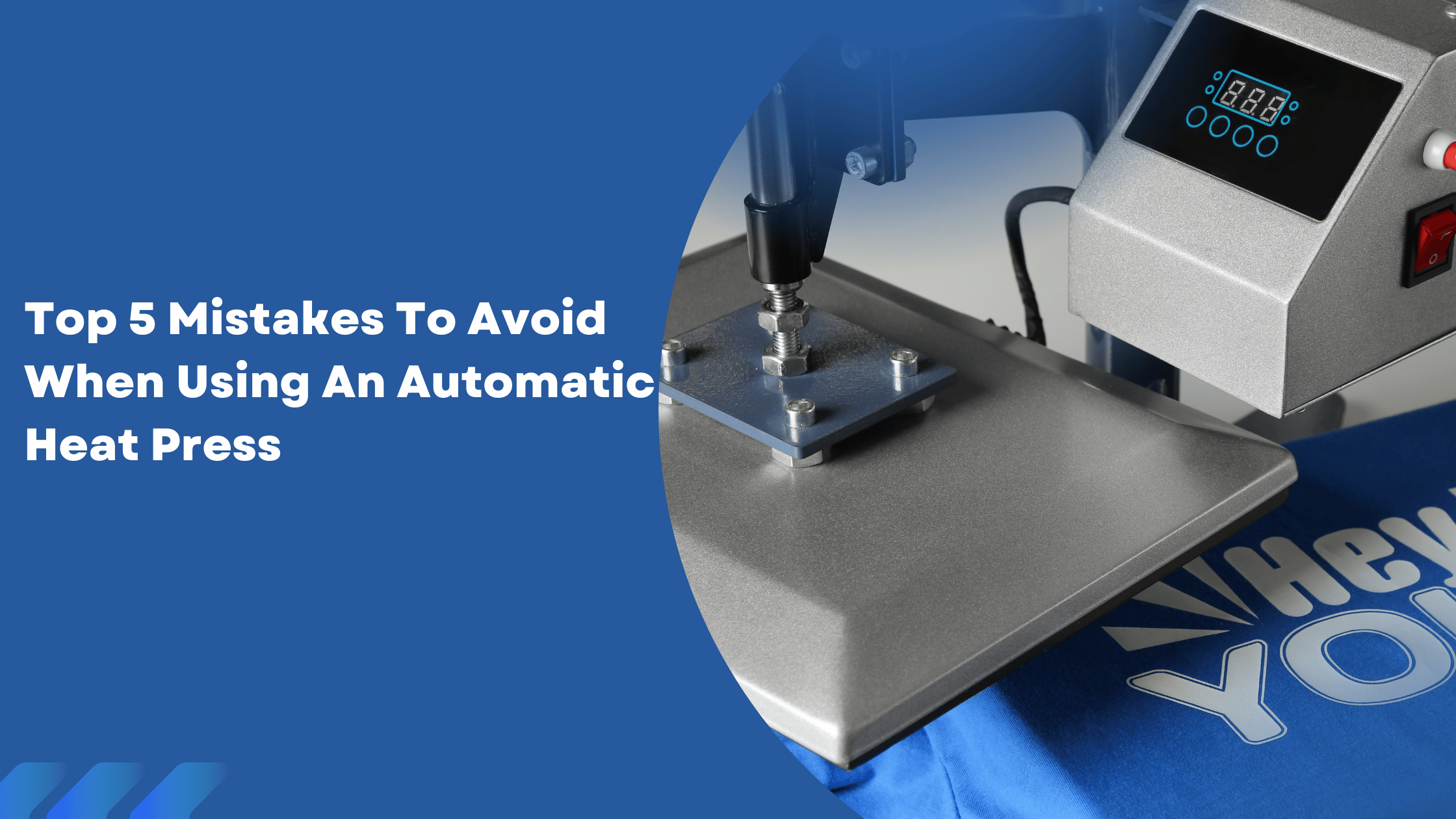Mastering The Automatic Heat Press For Perfect Results
An automatic heat press is an invaluable tool for custom printing businesses, allowing for higher efficiency, consistent results, and increased production speed. Unlike manual heat presses, which require manual opening and closing, an automatic heat press operates with minimal user intervention, making it perfect for large-scale production and reducing operator fatigue.
However, even the most advanced heat press can produce flawed prints, damaged materials, or operational inefficiencies if not used correctly. Many businesses unknowingly make common mistakes that can cost time, waste materials, and reduce the lifespan of the machine.
To help you maximize efficiency, print quality, and profitability, this guide covers the top five mistakes to avoid when using an automatic heat press and how to fix them. Whether you’re a beginner or an experienced user, avoiding these errors will ensure smooth operations and professional-grade results.
Table of Contents
-
Understanding the Importance of an Automatic Heat Press
- What is an Automatic Heat Press?
- Benefits of Using an Automatic Heat Press
-
Top 5 Mistakes to Avoid When Using an Automatic Heat Press
- Mistake #1: Using the Wrong Temperature and Time Settings
- Mistake #2: Applying Incorrect Pressure Levels
- Mistake #3: Skipping the Pre-Pressing Step
- Mistake #4: Neglecting Maintenance and Cleaning
- Mistake #5: Not Using the Right Transfer Materials
- Best Practices for Optimizing Heat Press Performance
- Common Troubleshooting Tips for Automatic Heat Press Users
- FAQs: Avoiding Mistakes with an Automatic Heat Press
- Conclusion: Maximizing Efficiency and Print Quality
1. Understanding the Importance of an Automatic Heat Press
What is an Automatic Heat Press?
An automatic heat press is a machine that applies heat, pressure, and time to transfer designs onto T-shirts, hoodies, tote bags, hats, mugs, and other substrates. Unlike manual heat presses, which require manual opening and closing, automatic heat presses open automatically when the timer ends, reducing operator workload and improving consistency.
Benefits of Using an Automatic Heat Press
Faster Production – Perfect for bulk orders and high-volume printing
Consistent Pressure & Temperature – Reduces human error and ensures uniform results
Reduced Operator Fatigue – No need for manual lifting and closing
Enhanced Print Durability – Ensures long-lasting, high-quality transfers
Despite these advantages, using an automatic heat press incorrectly can lead to common problems. Let’s explore the top five mistakes to avoid and how to fix them.
2. Top 5 Mistakes to Avoid When Using an Automatic Heat Press
Mistake #1: Using the Wrong Temperature and Time Settings
One of the most common mistakes heat press users make is applying incorrect temperature and time settings. Different fabrics and transfer materials require specific heat and time settings to ensure proper adhesion and durability.
Common Issues:
- Fading or peeling transfers due to too little heat.
- Burned or scorched fabrics from excessive heat.
- Wrinkled or distorted designs due to over-pressing.
How to Fix It:
- Follow Manufacturer Guidelines: Always refer to the recommended temperature and time settings for heat transfer vinyl (HTV), sublimation, direct-to-film (DTF), or screen print transfers.
- Perform Test Presses: Before full production, do a test press on a scrap fabric to ensure proper adhesion.
- Use an Infrared Thermometer: Check the actual platen temperature to confirm accuracy.
Mistake #2: Applying Incorrect Pressure Levels
Heat press machines require consistent, even pressure to transfer designs properly. Automatic heat presses offer adjustable pressure settings, but failing to set them correctly can cause poor adhesion, uneven transfers, or damage to delicate fabrics.
Common Issues:
- Designs not fully adhering due to low pressure.
- Overly stiff transfers due to excessive pressure.
- Indentations or scorching on delicate fabrics caused by too much force.
How to Fix It:
- Check Fabric Thickness: Adjust pressure settings based on fabric thickness. Thicker materials like hoodies require more pressure, while delicate fabrics like polyester need less.
- Use the Dollar Bill Test: Place a dollar bill halfway in the press and close it. If it slides out easily, increase pressure. If it can’t be pulled out, reduce pressure.
- Regularly Inspect Pressure Levels: Use a digital pressure gauge for consistent application.
Mistake #3: Skipping the Pre-Pressing Step
Pre-pressing is an often overlooked step that can significantly impact transfer quality. Pre-pressing involves pressing the fabric before applying the design to remove wrinkles, moisture, and static.
Common Issues:
- Wrinkled transfers due to uneven surfaces.
- Poor adhesion because of trapped moisture.
- Fabric shrinking after the final press, distorting the design.
How to Fix It:
- Pre-Press for 5-10 Seconds: Before applying the transfer, press the blank fabric for a few seconds to ensure a smooth, dry surface.
- Avoid Over-Pressing: Pre-press just enough to eliminate moisture and wrinkles—don’t overheat the fabric.
- Use Teflon or Parchment Paper: Place a protective sheet to prevent scorching.
Mistake #4: Neglecting Maintenance and Cleaning
A heat press is a long-term investment, but failing to clean and maintain it can lead to inconsistent performance, uneven heat distribution, and mechanical failures.
Common Issues:
- Uneven heating due to dirt buildup on the platen.
- Sticky residues from HTV or sublimation ink transferring onto other materials.
- Mechanical breakdowns due to neglected lubrication or worn-out components.
How to Fix It:
- Wipe Down the Platen Daily: Use a soft cloth and heat press cleaner to remove adhesive buildup.
- Lubricate Moving Parts Monthly: Keep hinges and automatic release mechanisms smooth.
- Check Wiring and Temperature Sensors: Ensure consistent performance with regular inspections.
Mistake #5: Not Using the Right Transfer Materials
Even with the perfect heat press settings, low-quality or incompatible transfer materials can ruin a print job.
Common Issues:
- Transfers peeling off after washing due to subpar adhesive.
- Colors fading quickly because of poor-quality sublimation paper or ink.
- HTV lifting from the fabric after a few wears.
How to Fix It:
- Invest in High-Quality Materials: Use trusted brands of HTV, sublimation paper, or DTF film.
- Check Material Compatibility: Ensure your heat press is compatible with different types of transfer materials.
- Store Transfers Properly: Keep vinyl and transfer papers away from moisture and heat.
3. Best Practices for Optimizing Heat Press Performance
Use an Automatic Timer: Set the correct heat press duration to avoid over-pressing.
Keep a Settings Log: Document ideal temperature, pressure, and time settings for different materials.
Train Your Team: If running a large-scale business, ensure employees follow best practices.
4. Common Troubleshooting Tips for Automatic Heat Press Users
| Issue | Possible Cause | Solution |
|---|---|---|
| Transfer Not Sticking | Low temperature or pressure | Increase temperature and check pressure settings |
| Fabric Scorched | Excessive heat or pressure | Lower heat settings and use a Teflon sheet |
| Uneven Transfer | Uneven pressure | Adjust platen and pressure settings |
| Residue on Platen | Leftover vinyl adhesive | Clean with heat press cleaner |
5. FAQs: Avoiding Mistakes with an Automatic Heat Press
Q1: Can I use the same settings for all materials?
No! Different materials require specific time, pressure, and temperature settings.
Q2: How often should I clean my heat press?
Daily for light cleaning, monthly for deep maintenance.
Q3: How do I avoid T-shirt scorching?
Lower temperature and reduce pressure, use a protective Teflon sheet.
Conclusion: Maximizing Efficiency and Print Quality
By avoiding these common mistakes, you can enhance print quality, extend machine lifespan, and improve workflow efficiency. With proper heat settings, pressure adjustments, and maintenance, an automatic heat press will help scale your business successfully.
Ready to take your custom printing business to the next level? Apply these tips today!

